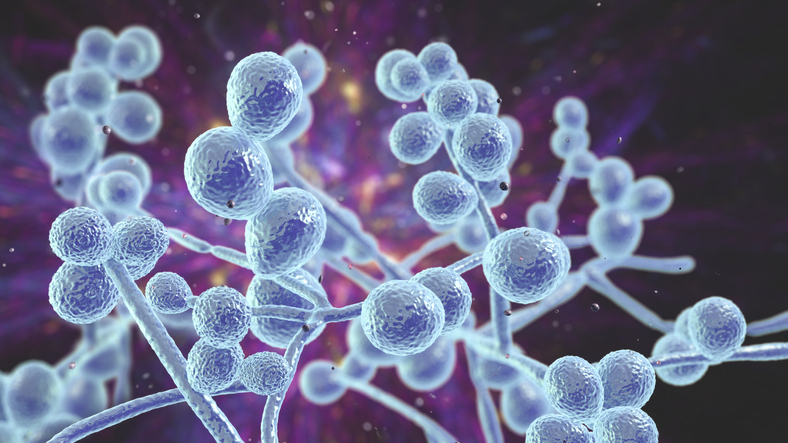Infection
Candida Albicans Produces Alzheimer’s-Like Changes in the Brain
Fungi are known to routinely infect the brain. Although they have been implicated in neurodegenerative conditions such as Alzheimer’s disease, specific anti-Candida immune pathways have not been defined. More generally, there is a limited understanding of how these microbes could be involved in the development of such conditions.
Now researchers have uncovered how the fungus Candida albicans enters the brain, activates two separate mechanisms in brain cells that promote its clearance, and generates amyloid beta (Ab)-like peptides—toxic protein fragments from the amyloid precursor protein that are considered to be at the center of the development of Alzheimer’s disease. More specifically, they show that C. albicans “activates microglia through two mechanisms involving the production of amyloid b-like peptides that signal through TLR4 and candidalysin that activates CD11b, together promoting clearance of C. albicans from the brain.”
This work is published in Cell Reports in the paper, “Toll-like receptor 4 and CD11b. expressed on microglia coordinate eradication of Candida albicans cerebral mycosis.”
“Our lab has years of experience studying fungi, so we embarked on the study of the connection between C. albicans and Alzheimer’s disease in animal models,” said David Corry, MD, professor of pathology and immunology and medicine at Baylor College School of Medicine. “In 2019, we reported that C. albicans does get into the brain where it produces changes that are very similar to what is seen in Alzheimer’s disease. The current study extends that work to understand the molecular mechanisms.”
First, they show that C. albicans enters the mouse brain from the blood and induces two neuroimmune sensing mechanisms involving secreted aspartic proteinases (Saps) and candidalysin.
“Our first question was, how does C. albicans enter the brain? We found that C. albicans produces enzymes (called secreted aspartic proteases or Saps) that breakdown the blood-brain barrier, giving the fungus access to the brain where it causes damage,” said Yifan Wu, MD, PhD, postdoctoral scientist in pediatrics working in the Corry lab.
Corry and his colleagues had previously shown that a C. albicans brain infection is fully resolved in otherwise healthy mice after 10 days. In this study, they reported that this occurred thanks to two mechanisms triggered by the fungus in microglia.
“The same Saps that the fungus uses to break the blood-brain barrier also break down the amyloid precursor protein into Ab-like peptides,” Wu said. “These peptides activate microglial brain cells via a cell surface receptor called Toll-like receptor 4 (TLR4), which keeps the fungi load low in the brain, but does not clear the infection.”
C. albicans also produces the candidalysin protein that binds to microglia via the CD11b receptor. “Candidalysin-mediated activation of microglia is essential for clearance of Candida in the brain,” Wu said. “If we take away this pathway, fungi are no longer effectively cleared in the brain.”
The authors summarized, “The Saps hydrolyze amyloid precursor protein (APP) into amyloid b (Ab)-like peptides that bind to Toll-like receptor 4 (TLR4) and promote fungal killing in vitro while candidalysin engages the integrin CD11b (Mac-1) on microglia.”
“This work potentially contributes an important new piece of the puzzle regarding the development of Alzheimer’s disease,” Corry said. “The current explanation for this condition is that it is mostly the result of the accumulation of toxic Ab-like peptides in the brain that leads to neurodegeneration. The dominant thinking is that these peptides are produced endogenously, our own brain proteases break down the amyloid precursor proteins generating the toxic Ab peptides.”
Here, the researchers showed that the Ab-like peptides also can be generated from a different source—C. albicans. This common fungus, which has been detected in the brains of people with Alzheimer’s disease and other chronic neurodegenerative disorders, has its own set of proteases that can generate the same Ab-like peptides the brain can generate endogenously.
“We propose that the brain Ab-peptide aggregates that characterize multiple Candida-associated neurodegenerative conditions including Alzheimer’s disease, Parkinson’s disease, and others, may be generated both intrinsically by the brain and by C. albicans,” Corry said. “These findings in animal models support conducting further studies to evaluate the role of C. albicans in the development of Alzheimer’s disease in people, which can potentially lead to innovative therapeutic strategies.”

